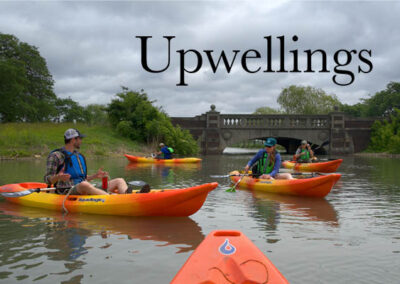School and community partners from the Northeast Michigan Great Lakes Stewardship Initiative explore how environmental-STEM learning can support student engagement in Great Lakes stewardship.
Imagine students spending an entire year studying marine debris and auditing their school cafeteria to learn about single-use versus reusable plastics – and then getting really excited to share their results with their entire school and community. This is just one example of a school project success story teachers learned about during a recent conference.
The Northeast Michigan Great Lakes Stewardship Initiative (NEMIGLSI) network partnership supports place-based stewardship education and connects schools with community partners, educators and youth seeking to enhance their learning through Great Lakes and natural resource stewardship projects.
Last month, more than 75 educators and community partners celebrated successes through this partnership during the 12th annual regional NEMIGLSI network meeting held in Alpena, Michigan. Facilitated by Michigan State University Extension (Michigan Sea Grant and 4-H Youth), NOAA Thunder Bay National Marine Sanctuary and Huron Pines AmeriCorps— among other leadership partner, this regional meeting serves to strengthen school-community partnerships across the region. Educators from more than a dozen schools came together with community partners to share educational presentations, trade resources and explore new ideas.
This year’s meeting offered an opportunity to celebrate a recent international Innovative Education award recognizing the NEMIGLSI network’s excellence in engaging students in environmental-STEM (science, technology, engineering, and math) learning experiences. This award from UL (underwriter laboratories) and the North American Association for Environmental Education (NAAEE) reflects how northeast Michigan students are applying their e-STEM learning in accomplishing meaningful stewardship projects of importance to their local communities. Christiane Maertens, Deputy Director from NAAEE, kicked off this year’s meaning as keynote speaker addressing the importance of this effort to engage youth, through their e-STEM learning, in environmental stewardship projects locally.
Engaging youth as community partners and leaders is a core principle for the NEMIGLSI network, and this meeting looked to cross-tie a series of new Guiding Principles for Exemplary Place-Based Stewardship Education (PBSE), a set of principles co-developed in collaboration with the Great Lakes Fishery Trust and nine statewide GLSI network hubs with support from the U.S. Environmental Protection Agency.
Drawing on the expertise of local NEMIGLSI network educators, the day’s educational panel presentations also included perspectives toward e-STEM learning applied in context of PBSE guidelines and best practices. These panelists shared as follows:
- Setting the focus: Community as the classroom (Tina Denbleyker, Lincoln Elementary, Alpena Public Schools) – Denbleyker has recently engaged her students in exploring local pollinator habitats along the Thunder Bay River within the city limits of Alpena. She shared how easy it was to take students on exploratory walks within their own community, connect pollinator (monarch butterfly) studies with important learning objectives like life cycles, and to connect with community partners. The city welcomed her student explorations, and even changed mowing practices to protect important pollinator habitats identified by students.
- Foundations for Place-Based Teaching: Team teaching, school culture, and community collaborations (Mike Berenkowski, Tim Lee, Matt Hinckley, and Matt McDougall, Oscoda Area Schools) – This Oscoda school educator team has excelled in integrating PBSE practices as a core educational strategy in their school. They shared a wide variety of projects that connected students with community partners, engaged students in environmental stewardship, and enhanced learning goals for their school. These educators stressed the importance of team teaching, coordinating with school administrators, and communicating student projects successes with community.
- Foundation for Place-Based Learning: Interdisciplinary opportunities in Shipwreck Alley (John Caplis, Alpena High School) – An Earth Science class, Caplis has designed his Shipwreck Alley course as a community-centered and interdisciplinary learning experience for students. His class incorporates history and social studies, Great Lakes science and ecology, and student leadership in community development projects such as the Great Lakes fisheries heritage exhibit in development with the Besser Museum for Northeast Michigan. Caplis centers his student studies on their local community and Great Lakes resources – from which many hands-on and interdisciplinary learning opportunities arise for students.
- Deepening the Impact: One issue, many projects, lots of learning (Alecia Deitz, All Saints Catholic School) – A simple question centered on the issue of marine debris in the Great Lakes launched Deitz into a year-long learning opportunity with students. Students conducted class cafeteria audits for single-use versus reusable plastics, and after collecting data, they hosted a schoolwide assembly where they highlighted the impact of the marine debris on the environment and shared the collected weekly tally for single-use plastics. Expanding their work into the community, students presented their research during the Thunder Bay International Film Festival and partnered in the NOAA Students for Zero Waste Week. Their efforts continued into student-led litter clean-up efforts and culminated with a student-planned Friday Earth Day Celebration complete with a ‘Trashion’ show. Most impressively, the artwork of Malley M., a 2015-16 eighth-grade student at All Saints Catholic School local youth leader was featured in the national 2017 NOAA Marine Debris Calendar. Deitz’s students illustrate how one Great Lakes issue can lead to lots of learning and many student leadership opportunities.
As part of the event, participants also learned about zero waste strategies as drink and food containers were reused or recycled and food waste and paper products were collected for composting. Less than a grocery bag of trash resulted from this meeting including more than 75 people attending.
In 2017, supported by Great Lakes Fishery Trust’s Great Lakes Stewardship Initiative funding, the NEMIGLSI network served 32 schools, supported 110 educators, and engaged 5,155 youth in place-based stewardship education experiences. These project partnerships show how place-based stewardship education strategies can enhance school and student learning through hands-on science learning in their community. This regional meeting reflected on these accomplishments, discussed upcoming opportunities, and engaged participants in planning toward a brighter future for the NEMIGLSI network.


